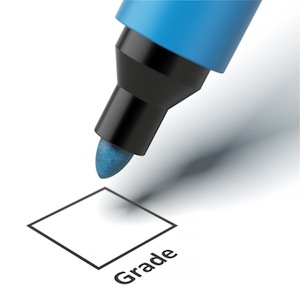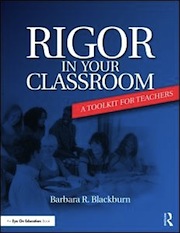Three Tips for Effective Grading

Grading was something I struggled with as a teacher. But I’ve learned there are several characteristics that can help assure we have a fair and well-thought-out grading system that supports rigor in our classrooms.
To discuss effective grading, let’s look at an actual middle school social studies assignment. Students in the class had studied individuals who made contributions during the Renaissance and Reformation. They were to pick one individual and create a “wanted” poster. The complete assignment and scoring looked like this:
- Poster must be on an 8 ½ by 11 sheet of paper (10 points)
- Mug shot (10 points)
- First and last name of historical figure (5 points)
- Birth date and year of death (5 points)
- Country they were born in and where they did their work (10 points)
- What they were famous (wanted) for; 5-7 sentences? (30 points)
- An interest fact or quote (10 points)
- A printout of sources with highlighted information (15 points)
- Your name in the bottom right corner (5 points)
In effective grading, we need to consider three things: the purpose of the assignment, the type of grading, and whether or not there are options. How does this assignment measure up?
What is the purpose or outcome?
What is your purpose for grading a particular assignment? Are you setting a benchmark to see which of your students have met a standard? Or are you evaluating their progress, so you can make decisions about your future instruction?
The teacher’s purpose here was basic—for students to summarize information about an historical figure. But is that appropriate at the middle school level?
Realistically, by the time students are in the middle grades, we should be moving beyond summarizing to synthesis and analysis. This is reinforced in the Common Core and other rigorous state standards. You may start with a summary, but certainly students should move beyond that.
What exactly am I grading?

When I met with this teacher, I recommended revising the grading rubric, counting completion of basic items as 10% of the grade. Other portions of the revised rubric included:
► [20%] Connections: Narrative includes key life events, family, possible associates, other locations visited or other places the person lived to help with locating the person.
► [25%] Synthesis: Information in paper is synthesized and confirmed from multiple sources (minimum of five), rather than summarized from an isolated source. It is also cited appropriately to demonstrate synthesis.
► [25%] Analysis: As a conclusion, narrative includes an analysis of the individual, including strengths, weaknesses, and possible other contributions the person could have made to society or the movement. Although your opinion, analysis should be based on the information gathered.
► [20%] Written narrative: Overall flow and quality of writing, appropriate information included, extraneous information excluded. Quotes and other information support key points made throughout the paper.
What if students aren’t successful?
A final consideration in grading is the next step if a student fails the assignment. When it is a formative assessment, it may be as simple as to use the information to adjust your instruction. But what if it is a summative assessment, and it is a major part of the student’s grade?
Consider allowing the student to redo the assignment, such as redoing a math test for partial credit. The major objection that often comes up is that students won’t learn to be responsible if they are allowed a second chance. But in real life, in the workforce, adults are given additional opportunities to improve their work all the time.
For example, if your principal requires you to turn in lesson plans and you don’t, you aren’t automatically fired. You are probably asked to turn them in immediately or by a clear deadline. You’re not offered the choice to fail or take a zero on your lesson plans.
Yet that’s exactly what happens with students. At times, they simply don’t do the assignment, or they complete it unsuccessfully. We hold students to a higher standard when we require them to do their work at an acceptable level. This is commonly known as having a “not-yet” policy (grades are A, B, C or Not Yet) or the Power of the Incomplete (where an assignment is incomplete until it is satisfactory).
Requiring quality work is a challenge for teachers, especially when it means working with students for a longer period of time until they can complete the work successfully. But over the course of a year, what you are doing is building a stronger foundation of success. Students come to see that they do need to learn the material and demonstrate their learning. Failure is truly not an option.
Remember: Why, what and how
Grading is a complex enterprise, encompassing many factors, not the least of which is teacher (as well as student) accountability. As we search for the most effective grading practices, it’s important to consider why we grade, what we grade, and how our practices can help students truly be successful.

Barbara’s latest book, Rigor in Your Classroom: A Toolkit for Teachers, was published in May 2014 by Routledge/Eye on Education.


































Grading as a whole is misguided and obsolete. They do more harm than good. Whose honest, careful evaluation of MY work is more valuable: someone else’s or my own? We need young people to begin evaluating their own work and developing skills to improve it. The world is going to need people who are autodidactic, independent, entreprenuerial problem-solvers. Assigning a grade is one of the many policies in conventional education that retard development. Brain research confirms this: the best most lasting and meaningful learning comes from what we are intrinsically motivated to learn, and ANYTHING can be learned through intrinsic motivation. Grades are simply a system of reward and punishment, the basest form of extrinsic motivation. The conviction that kids can’t assess their own work well, even at very young ages, is based on an understanding of human development that is simply wrong. Grades do not result in quality learning. They result in grades. Kids need us to guide them, not to assign an arbitrary and largely meaningless letter or number to their work. Yes, assess students and use assessments to guide learning and direct students to resources, but grades have got to go. This is not a pipe dream. Schools and teachers around the world are already doing it with extremely positive results. Over 40 years of research into the brain and how it learns clearly demonstrate that grades do more harm than good. Decades of psychological research also suggest this: see the work of Rueven Feuerstein and Mihaly Csikszentmihalyi, for example. Read Daniel Pink’s book “Drive” or “How We Learn,” by Benedict Carey. Look up Mark Barnes and Teachers Throwing Out Grades on Facebook.